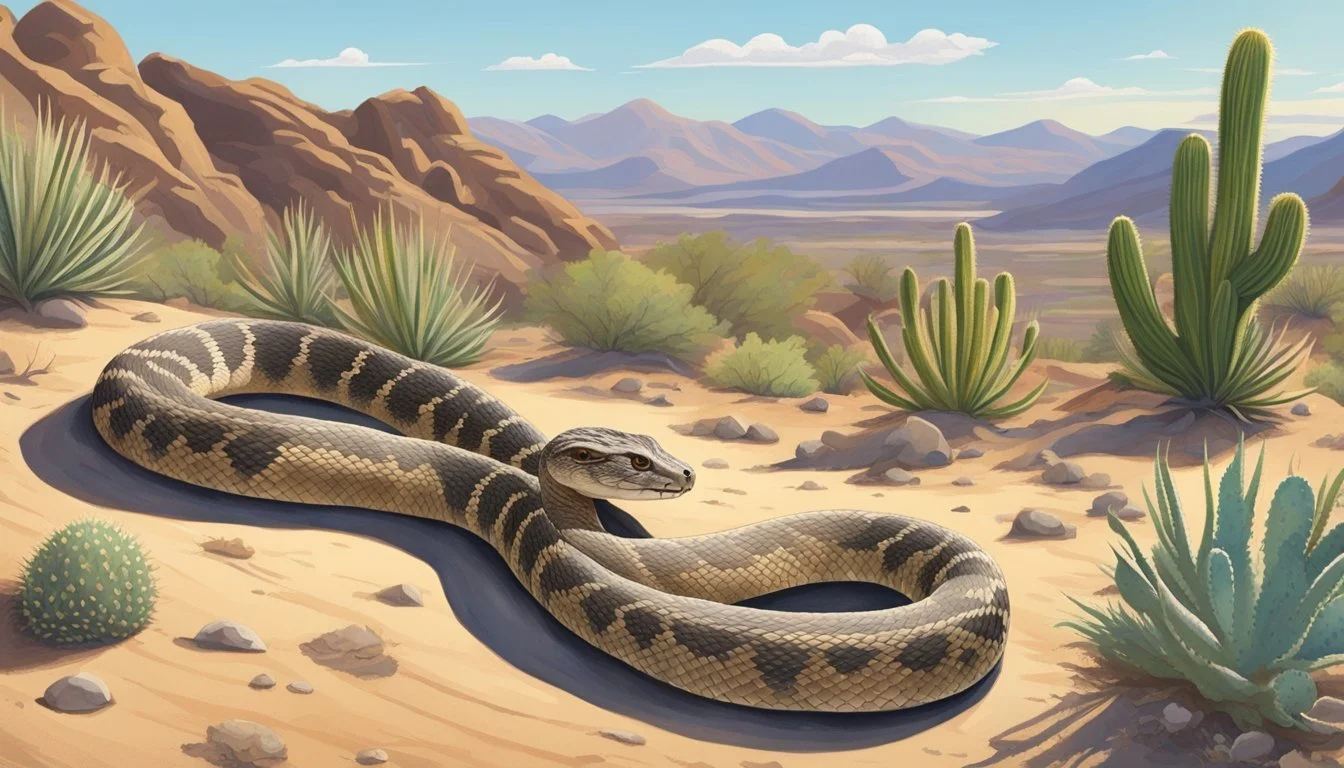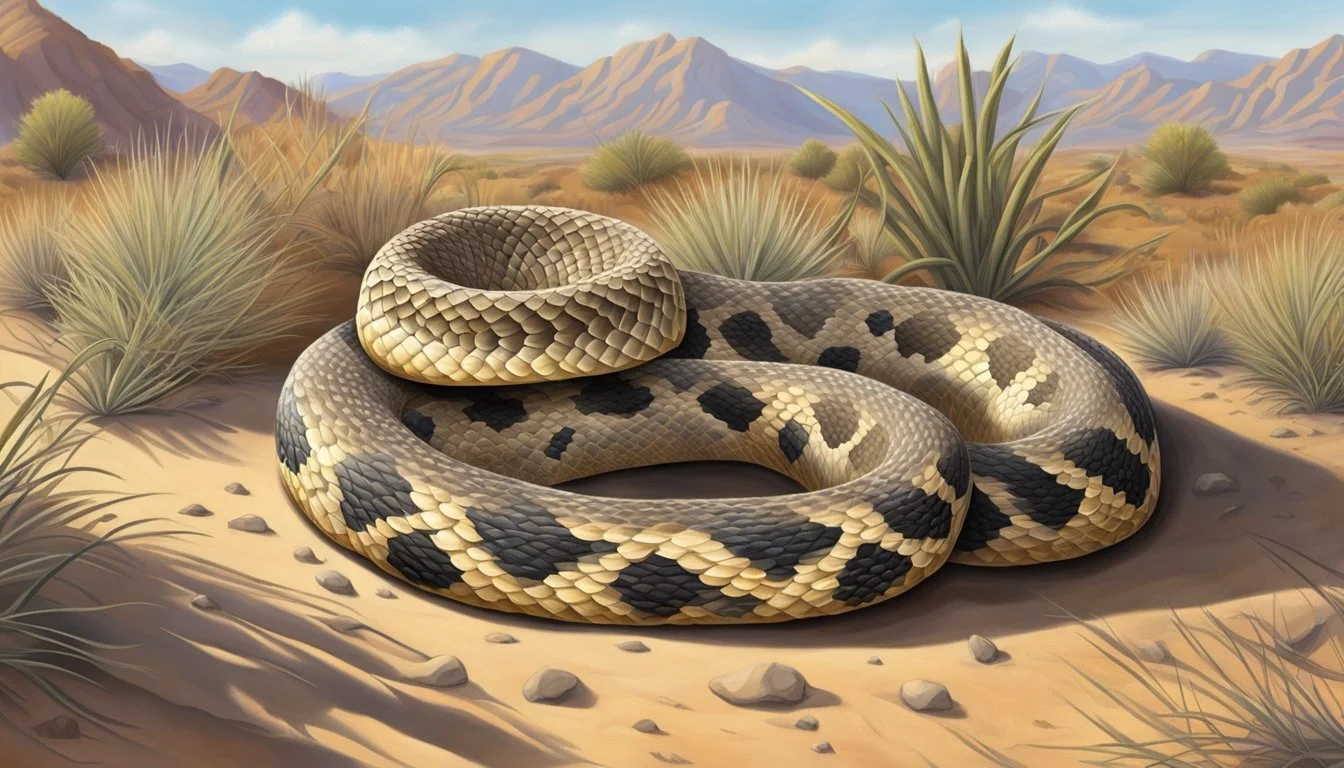Rattlesnake Culinary Adventures
Savoring Southwestern America's Bold Flavor
Rattlesnake meat is a lesser-known culinary choice, yet it holds a certain cultural and historical significance in the American Southwest. Often overshadowed by more common meats like beef or pork, rattlesnake presents a unique flavor and texture to those willing to try it. It is considered a delicacy in some circles, particularly among those who appreciate unusual and region-specific food experiences.
Dining on rattlesnake is not as widespread as other game or exotic meats, yet it can be found on menus in states like Arizona, where the speckled rattlesnake—a native species—is sometimes harvested for this purpose. The preparation of rattlesnake meat is varied, ranging from simple grilling to being featured as part of a more complex dish. Frequently compared to poultry in taste, it's often cooked with spices that complement its distinct flavor profile.
Rattlesnake Characteristics
Rattlesnakes are known for their distinctive tail rattle and potent venom. Understanding their anatomy and the array of species is critical when discussing this fascinating group of serpents.
Anatomy and Morphology
Rattlesnakes possess a robust anatomy, characterized by large triangular heads and sturdy bodies. The rattle, located at the tail's end, is made of interlocking keratin segments, and a new segment, or button, is added each time the snake sheds its skin. Their efficient venom delivery system includes hollow fangs connected to venom glands. The fangs fold against the roof of the mouth when not in use.
Diversity and Species
Belonging to the subfamily Crotalinae, commonly known as pit vipers, rattlesnakes include the genera Crotalus and Sistrurus. Notable species include the Eastern Diamondback (Crotalus adamanteus), the largest, and the Western Diamondback (Crotalus atrox). Other species, like the Timber Rattlesnake (Crotalus horridus), contribute to the diversity of this group. The size of rattlesnakes can vary greatly, with adults ranging from 0.5 meters (1.6 feet) to over 2 meters (6.6 feet) in length.
Ecology and Habitat
Rattlesnakes, a long-standing American Southwestern specialty, are notably known for their diverse habitats and extensive hunting abilities across North America.
Geographic Distribution
Rattlesnakes occupy various ranges predominantly in the Southwestern United States and extend into Northern Mexico. The Eastern Diamondback thrives in the southeastern states, often in coastal plain forests, while the Western Diamondback is prevalent in the arid regions of the Southwest. They frequent environments such as:
Deserts
Grasslands
Forests
Swamps
Their habitats include the ground level of these ecosystems, often in regions that facilitate burrowing or provide shelter.
Diet and Hunting Methods
Rattlesnakes are carnivorous, with a diet consisting primarily of:
Rodents
Lizards
Small Birds
Hunting methods are distinguished by impressive strategies that include ambush predation, with the snake lying in wait for unsuspecting prey. They utilize a combination of heat-sensing pits and keen eyesight to detect and strike with precision. Following a successful bite, rattlesnakes track the envenomated prey until it succumbs, after which they consume it whole.
Life Cycle and Reproduction
Rattlesnakes exhibit distinct reproductive behaviors and a complex development cycle from birth to adulthood. Understanding these facets is crucial in appreciating how they sustain their populations across varied North American landscapes.
Mating Behaviors
Spring emerges as a critical period for rattlesnake reproduction. As the cold of winter wanes, rattlesnakes become more active and males begin the search for potential mates. The males engage in combat to assert dominance and earn the right to mate with receptive females. Post-mating, females will store sperm internally until ovulation, ensuring the fertilization of eggs within their bodies.
Offspring and Development
Rattlesnakes are ovoviviparous reptiles, meaning females carry eggs internally and give birth to live offspring. The gestation period typically lasts 3 to 4 months, often culminating with births occurring in the late summer. Following this, newborn rattlesnakes are incredibly self-reliant; they come into the world fully developed and are capable of hunting and defending themselves from the outset. Throughout the course of their lives, which can span between 10 to 25 years, rattlesnake offspring periodically shed their skin to accommodate growth—a process occurring several times yearly.
Human and Rattlesnake Interactions
Interactions between humans and rattlesnakes can be perilous due to the venomous nature of these reptiles, yet ongoing conservation efforts seek to protect both species and their shared habitats.
Bites and Safety Measures
Rattlesnakes have a well-deserved reputation for being one of North America's most dangerous snake species due to their venomous bite. Human encounters with these snakes can lead to serious injury or, in rare cases, death. Immediate medical attention with the right antivenin is critical to treat a rattlesnake bite effectively, which can otherwise result in severe tissue damage or fatalities. When in rattlesnake habitats, it is advisable for individuals to:
Stay on well-used paths.
Wear boots and long pants for protection.
Be cautious when moving rocks or brush, as these are common hiding spots for snakes.
Avoid disturbing a rattlesnake if encountered; instead, back away slowly and give the snake space to retreat.
Conservation Efforts
While rattlesnakes can be dangerous, they are also predators that play a crucial role in the ecosystem, controlling populations of their prey. Many species of rattlesnake are now facing challenges due to habitat destruction and are considered endangered. Conservationists, recognizing the importance of maintaining rattlesnake populations, have been working to:
Monitor population levels to understand trends and identify risks.
Implement protective legislation to prevent illegal killing of rattlesnakes.
Educate the public on the importance of conserving rattlesnake species and their natural habitats.
Efforts such as these contribute to the overall health of ecosystems and help maintain balanced and functioning environments where rattlesnakes and humans can coexist safely.
Cultural and Historical Significance
Rattlesnakes have long been a part of the cultural and historical fabric of the Americas, carrying deep significance for indigenous cultures and continuing to influence modern society.
Rattlesnakes in Indigenous Cultures
Indigenous peoples across the Southwest have revered rattlesnakes (Crotalus and Sistrurus species) for their potent venom and significant roles in traditional narratives. For many Native American tribes, these venomous snakes symbolize various attributes such as protection, wisdom, and fertility. The rattlesnake's rattles are not only a warning mechanism to deter predators but are also seen as symbols of transformation due to their growth each time the snake sheds its skin. This potent image integrates the rattlesnake into ceremonial rituals and art, reflecting its respected status within these cultures.
Key entities: Crotalus, Sistrurus, venom, rattles, indigenous cultures
Reverence: Protection, wisdom, fertility symbols
Artistic significance: Rattlesnakes featured in rituals, artwork
The Rattlesnake in Modern Society
In modern times, the image of the rattlesnake remains potent within the cultural landscape of the United States, particularly in the Southwest. The Eastern Diamondback and the Western Diamondback are among the most recognized rattlesnake species, known for their distinctive patterns and potent venom. Both have influenced local folklore and are part of the conversation surrounding conservation efforts. The rattlesnake's portrayal as a symbol of readiness and defense traces back to its use on the Gadsden Flag during the Revolutionary War, underlining its continued emblematic role in American society.
Key entities: Eastern Diamondback, Western Diamondback, United States, Southwest
Cultural portrayal: Emblem of readiness and defense
Conservation: Subject of preservation and ecological discussions
Rattlesnake Survival Strategies
Rattlesnakes possess a complex array of survival tactics, which have evolved over time to ensure their persistence in diverse environments. These strategies entail both remarkable adaptations to their environment and highly effective defense mechanisms.
Adaptations to Environment
Rattlesnakes exhibit several behavioral and physical adaptations that enable them to thrive. Key among them are:
Camouflage: Their skin patterns provide camouflage against the rocky and sandy terrains, rendering them nearly invisible to both predators and prey.
Hibernation: To survive the cold months, rattlesnakes enter a state of hibernation, seeking shelter in rock crevices or burrows.
Nocturnal Activity: Many species have become nocturnal, hunting in the cooler evening hours to avoid the extreme heat of the day.
Defense Mechanisms
Beyond their environmental adaptations, rattlesnakes have developed several defense mechanisms that characterize them as formidable pit vipers.
Venomous Bite: Armed with fangs that deliver a potent venom, they can immobilize or kill both threats and prey.
Rattle: As a warning signal, the distinctive rattle at the end of their tail deters would-be predators by signaling the snake's presence and readiness to defend itself.
Thermal Sensing: Utilizing heat-sensitive pits, they can detect warm-blooded animals, aiding in defense and hunting, especially under the cover of darkness.
The Culinary Journey
Rattlesnake meat has carved a unique niche in Southwest American cuisine, emerging as a true test of one's adventurous palate. While it may not be commonplace, its presence in the culinary scene denotes a rich history and a modern evolution of taste.
Traditional Uses
Historically, rattlesnake has been more than just an exotic menu item; it served as a significant source of sustenance. Indigenous tribes and early settlers in the Southwest utilized rattlesnake meat as a vital part of their diet, where food sources were often scarce. They employed every part of the animal, ensuring nothing went to waste. Common preparation methods included:
Boiling - to create hearty soups and stews.
Grilling over open flames - for a smoky flavor.
Drying - to preserve the meat for later consumption.
Modern Cuisine
Today's culinary landscape has transformed rattlesnake as food into a contemporary delicacy that intrigues both chefs and diners alike. It is often found in festivals and specialty restaurants, highlighting the evolving American Southwest diet. Modern culinary applications of rattlesnake include:
Deep-frying - offering a crisp texture.
Marinating - with ingredients like olive oil, garlic, herbs, and citrus to tenderize and flavor the meat.
Chefs recommend cooking the rattlesnake meat to an internal temperature of 165°F (74°C) to ensure safety. The lean, white meat (What wine goes well with white meat?) is frequently compared to chicken in taste and can be creatively incorporated into dishes alongside traditional southern sides, such as coleslaw and cornbread, enveloping it with both old-world charm and new-world flair.









